
Foil Aspect-Ratio: Everything you Need to Know About Low Aspect vs. High Aspect Foils
“8.6... 1840cm… 700mm.. Hut Hut Hike!” Choosing a foil can be confusing, and getting it wrong can leave you feeling sacked. In this article, we’re going to demystify foil aspect-ratio for wing foiling. By the end of this short read, you’ll have a clear idea of what aspect-ratio is, who each aspect-ratio is best for, and how to factor in foil size when choosing your next hydrofoil.
What are Aspect-Ratio Wing Foils?
The Aspect-Ratio (AR) of a foil is the relationship between span (how long) and area (how big).
Example: If a foil has a span of 70 cm and a size of 900 cm, let’s math it up!:
(span²) ÷(size) -> (70²) ÷ (900) = 5.4 Aspect-ratio
You might have been told that AR is the relationship between span and chord, however, this formula only works for wings that are rectangular. Because our foils have curves and tips that get skinnier, we must use span and surface area.
Now that you have enough mathematical ammunition to correct the entire rigging area (please don’t do this), let’s move on to the more important part; how aspect-ratio translates to the feeling of riding and achieving our wing foiling goals.
The Aspect-Ratio Spectrum:
Foil aspect-ratio generally runs anywhere from 3 (very low aspect) all the way to 13 (very high aspect). These extreme measurements are uncommon to come across. The majority of foils sit within the range of 5 to 10. The chart below provides an excellent overview of what each aspect-ratio in the common range has to offer. In order to best contextualize each size, let’s start on the ends and work our way in.
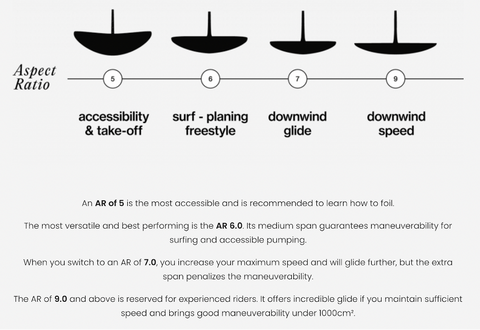
F-One “foil Progression” Chart
On one end of the spectrum, low-aspect foils excel at carving and early lift. On the other end, high-aspect foils glide endlessly and ride with great speed. As we move towards the center, hydrofoils begin to lose characteristics from one end of the spectrum and gain characteristics from the other.
A note on size:
Generally, as aspect-ratio increases, you’ll want to decrease size to keep a comfortable ride. The exceptions to this are for downwind, when we want a large high-aspect foil, or freestyle/big wave, where we want a small low aspect foil. Otherwise, as you go up in aspect ratio, you’ll want to go down in size.
Low-Aspect Ratio Foils (4 & 5)
At larger sizes, this is the AR of choice for beginners. At smaller sizes, this is the AR of choice for freestyle and big wave riders.
We Recommend:

F-One Gravity Carbon - size 1800 (AR = 5.0)
This is the foil to choose if you want to learn how to use both a wing and a foil. Accessible and straightforward, the GRAVITY foils have great lift and stability.
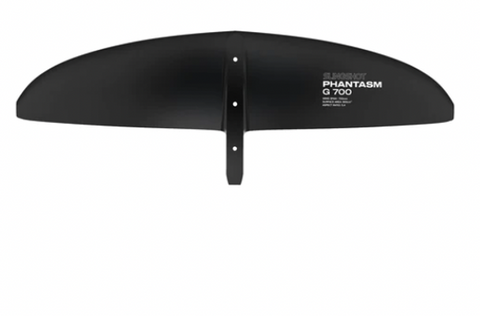
Slingshot Phantasm G-700 - size 900 (AR = 5.4)
This high performance wave / freestyle front wing provides unreal carving and pop while jumping. The G-700 wing combines a short wingspan for enhanced speed and maneuverability with a flat bottom profile that ensures a stable glide, making it the top choice among advanced wing foilers seeking both speed and smooth landings during jumps.
Pros:
- Easy lift-off
- Most maneuverable relative to size
- Less likely to breach
- Great carving
- Durable for jumping
Cons:
- Less glide
- Less pumping efficiency
But what does it feel like?
When considering large wing foils (1600cm - 2200 cm) and smaller wing foils (750 cm - 900 cm), low-aspect foils really are two different beasts. In this section, we’ll go into some detail about these two categories of foils.
Larger (1600 cm - 2200 cm) Low AR foils:
For riders learning to wing, large low aspect ratio foils are the right choice. These foils help you learn to get on foil and to gain basic control of the foil. The easy lift-off supports a rider’s skills development, making the learning process accessible. These foils excel in light wind and are the ideal platform for new riders. In larger sizes, these foils will generally have low speeds, however, this is due to the size more than the Aspect ratio.
Key Takeaway: Large low-aspect foils are slow, stable, and help the rider get on foil easily.
Smaller (750 cm - 900 cm) Low-aspect foils:
Smaller low-aspect foils are loved by advanced riders for their direct carving response, forgiving nature, and excellent control. These foils allow for powerful and precise carving from the moment you start riding. They recover well after breaches and provide smooth landings when jumping, allowing for quick transitions back into flight. With aggressive pop for jumping and neutral performance during carves, these foils are the top choice for big wave riding and freestyle action.
Low Mid-Aspect Foils (6 & 6.5)
The ATV of foils, low mid-aspect foils do it all. With well rounded glide, maneuverability and stability, low mid-aspect foils cover a wide range of characteristics.
We Recommend:
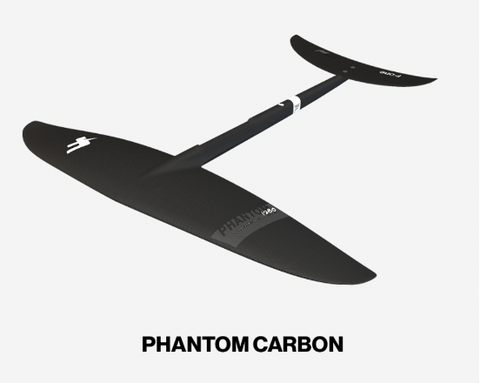
F-One Phantom - size 1280 (AR = 6.0)
The F-One PHANTOM foil (AR 6.0) is a versatile choice for foilers seeking enhanced performance and glide. With excellent maneuverability for surf foil, efficient pumping, and a medium span, it is a must-have foil that excels in many aspects and should be a part of every foiler's equipment collection.
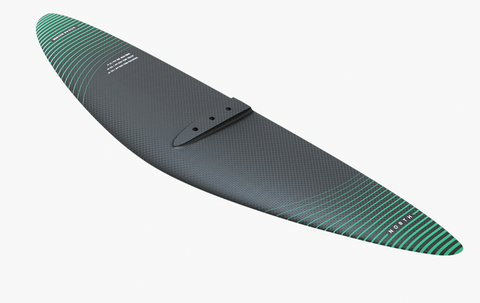
North Sonar MA - size 1050 (AR = 6.2)
An agile, fast-turning wing with incredible speed range and maneuverability. The North Sonar MA Front Wing is your go-to wing when the breeze is up or in medium waves. Balanced feel and powered-up performance, with exceptional ease of use.
Pros:
- All around performance
- Use in any conditions
- More glide than true low-aspect
- Better pumping than true low-aspect
- Best foil to experiment with pumping/swell riding
- An excellent first upgrade/step down in size for new riders.
Cons:
- Some characteristics may feel lacking
- less maneuverability than true low-aspect
But what does it feel like?
With greater span than true low-aspect foils, low mid-aspect foils begin to unlock gliding and pumping potential while still remaining ultimately stable and easy to use. While these foils still feel more like low-aspect foils than high-aspect foils, they begin to show some traits such as better gliding.
Low Mid-Aspect foils:
Our first departure towards high-aspect town, low mid-aspect foils take a conservative step away from the traits of true low-aspect foils. If you are looking for a well-rounded “do it all” foil, or a single foil quiver for light wind and high wind, this is the category of foil for you. However, if you are looking for a meaningful and noticeable increase in pump and glide performance, sit tight till the next stop.
These foils range from sizes 1680 cm to as small as 740 cm. As size decreases, maneuverability and speed increase. At smaller sizes (740 cm - 1000 cm) these foils are an excellent platform to do freestyle. Similarly, because of its increased glide and speed, these foils make for an excellent medium (3-5 foot +) to large wave (Overhead +) riding wing.
Something left to desire:
As a tradeoff to the well-rounded performance, riders may be left feeling caught in the middle of carving and gilding. Because these foils are designed to do both well, they can not be expected to do either fully. If you know you want a foil to do something specifically well for your conditions, it might be worth considering a foil that has those traits rather than an all around foil.
Key Takeaway: Low mid-aspect foils truly “do it all.” At smaller sizes, these foils can be ripping surf foil and medium wave foils due to increased glide and speed.Mid / High Mid-Aspect Foils (7-8)
The current trend in foil choice of intermediate and advanced riders looking for the “best of both worlds,” mid and high mid-aspect foils hit a sweet spot for glide, stall speed, pumping, and carving.
We Recommend:

F-One Seven Seas - size 1000 (AR = 7.5)
The F-One SEVEN SEAS foil is the ideal choice for those seeking increased glide, higher speeds, and excellent upwind capabilities. With a higher aspect-ratio of 7.5, it performs exceptionally well for surfing swells and downwinding in light winds and small chops. Its optimized design minimizes drag and reduces arm fatigue during upwind travel.
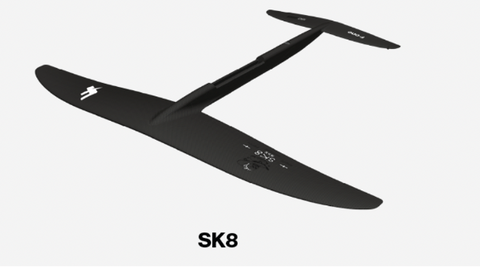
The SK8 foil, featuring an aspect-ratio of 8, is specifically designed for an exceptional surfing experience. Offering control, maneuverability, and impressive glide, this foil allows you to carve precise lines, elevating your surf foiling performance. Its outline enables easy turning and the ability to execute powerful, controlled carves with ease.
Pros:
- Amazing glide
- Greatly increased pumping ability
- Remarkable stability
Cons:
- Less maneuverability than lower-aspect foils
- More likely to breach tips
- Slightly more speed required to get up on foil
But what does it feel like?
With an even greater span than low mid-aspect foils, mid and high mid-aspect foils provide a rider with meaningful improvements in gliding and pumping responsiveness.
Mid / High mid-aspect foils:
Like low mid-aspect foils, mid and high mid-aspect foils take “do it all” to the next level. Cranked to eleven, high mid-aspect foils are the well rounded foil of choice for intermediate and advanced riders. Whether you want to glide, carve, swell ride, or downwind, mid / high mid-aspect foils are the platform that will best support a wide variety of “no-wing” riding styles.
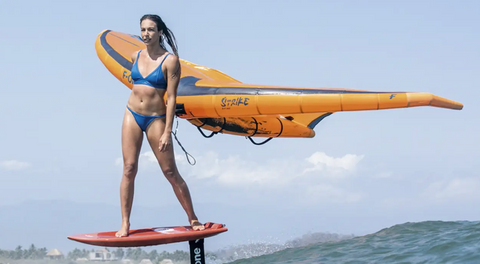
Rider Marcela Witt riding “no-wing” during a stylish downwind session
Pumping
When riding these foils for the first time, a rider will immediately notice that pumping is much more responsive than with their lower-aspect foil. When you push down into the wing board, these foils respond, pushing back and keeping the rider high on the mast. These foils allow for more pumping distance with less energy spent.
Gliding
At this-aspect ratio, hydrofoils still retain a low stall speed, meaning that they can ride at low speeds before dropping from flight. The ability to go slower is desirable in some conditions. For example, if we want to ride slower moving swells. In order to do this, we must match the speed of the swell. The wide speed range of high mid-aspect foils allows for matching the speed of slower and faster swell/waves.
Carving
Generally a tradeoff happens when span increases: More span (glide) means more difficulty in carving. The balancing act between glide and carve finds a euphoric equilibrium in high mid-aspect foils. While these foils do not carve as extreme as a low -aspect foil, and do not glide as extreme as a high-aspect foil, they do both at a high level. If you want to both carve and glide, set your sights on these foils.
Key takeaway: The “do it all” choice for intermediate and advanced riders. The increased span allows for improvements in glide and pumping while still carving well.
High-Aspect Foils (9-10)
If gliding on the smallest swell is your goal, high-aspect foils are the tool you need. Providing unreal pump and glide, these foils allow “no wing” swell riding as long as there is swell. For speed demons, a small high-aspect foil allows for personal records in speed.
We Recommend:

F-One Eagle - size 990 (AR = 9.5)
Whether you're freeflying or riding downwind, the EAGLE provides unparalleled stability, control, and an immersive experience that allows you to go faster, farther, and longer on the water. This foil is a game-changer for experienced riders seeking to fully unlock its potential and enjoy the thrilling sensations it brings.
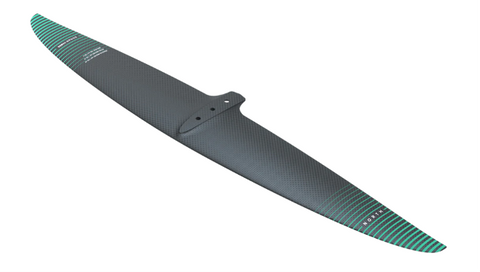
North Sonar HA - size 850 (AR = 9)
The North HA850 foil wing is engineered for ultimate speed and efficiency, offering minimal drag and maximum performance for intermediate to advanced wing-foil riders. Its smaller size, higher stall speed, and wingtip design with zero ventilation during tip-breech enable faster, tighter turns, while requiring minimal pumping and power for a smooth glide.
Pros:
- Endless Glide
- Ridiculously efficient pumping
- Very stable at top speeds
Cons:
- More speed required to get going
- More difficult to carve at larger sizes
- Higher stall speed
- More prone to breaching tips
But what does it feel like?
Riding a high-aspect ratio foil for the first time offers a heightened sense of control, increased speed, and dramatically increased gliding. Keep in mind that these foils require adjustments in weight distribution and technique to fully harness their potential.
High-aspect ratio foils:
Take everything about a foil and crank it to the extremes. High-aspect foils are recommended for advanced riders as they can be more difficult to control. When mastered, high-aspect foils open the doors to new levels of performance while foiling.
The good
A high-aspect foil is faster, glides further and pumps easier than any other shape of foil. At smaller sizes, these foils allow for the closest feeling to zero drag imaginable. These high speed foils are the top choices for racers. At larger sizes, riders can pump and glide on swells that would be unimaginable on any other foil. These are the foils of choice for downwinder riders.
The bad
These foils take everything to the extremes… everything. Their increased span means that carving them is more difficult and requires better foot placement or weight distribution. These foils also must be kept at high speeds to keep riding. Once mastered, these issues become areas for rider improvement.
The ugly
The first thing riders will notice about these foils is their sharp tips. Please be very careful when using these foils as they are very pointed. Check out our article on falling better while wing foiling to learn to work around this. Finally, keep in mind that these hydrofoils are generally not suitable for jumping.
Key Takeaways: High-Aspect ratio foils excel and pump and glide, allowing advanced riders to increase their riding performance dramatically.
Aspect Ratio Demystified
This article provides a comprehensive guide to understanding foil high aspect vs low aspect ratio foil wings. It discusses the different categories of aspect ratios, ranging from low to high, and their characteristics.
For low-aspect foils (4 & 5):
We recommend options such as the F-One Gravity Carbon and Slingshot Phantasm G-700, for their lift, stability, carving ability, and suitability for beginners or freestyle riders. Larger low-aspect foils are slow and stable, while smaller ones excel in wave riding and freestyle.
Low mid-aspect foils (6 & 6.5):
We recommend the F-One Phantom and North Sonar MA. These foils are versatile and well-rounded, offering a balance of glide, maneuverability, stability, and all-around performance. They are suitable for various conditions and can be used for surfing, pumping, and medium to large wave riding.
Mid/high mid-aspect foils (7-8):
We recommend the F-One Seven Seas and F-One SK8. These foils hit a sweet spot for glide, stall speed, pumping, and carving. These foils are recommended for intermediate and advanced riders who want a versatile option that excels in various riding styles.
High-aspect foils (9-10):
We recommend the F-One Eagle and North Sonar HA. These foils are designed for maximum glide, pump efficiency, and speed. They require more skill to control and carve, but offer unparalleled performance for experienced riders. Riding a high-aspect foil provides a heightened sense of control, increased speed, and dramatically increased gliding. However, keep in mind the added challenge of carving, the need for higher speeds, and the sharp tips that require caution.
We hope to have demystified aspect-ratio. Now, you can choose the right foil for your needs, and make informed decisions based on your riding goals and skill level. See ya out on the water!


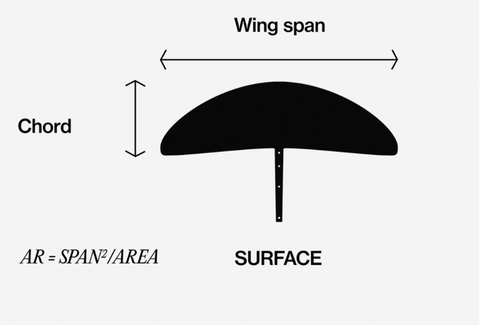
Leave a comment